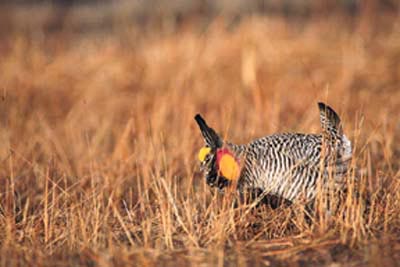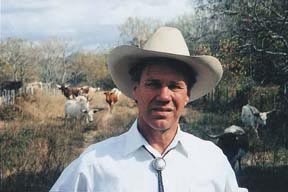|
|
|
| Subscriptions click here for 20% off! | E-Mail: info@rangemagazine.com |
|
|
|||||||||||||
 |
|||||||||||||
| OPPOSITE: Greater prairie chicken in spring showing “booming” behavior. Photo by Dominique Braud/Tom Stack & Assoc. | |||||||||||||
Safe HarborPrairie chickens and cows are strange rangefellows. But in Texas,
it works. |
|||||||||||||
| Before emptying into the Gulf of Mexico, the San Bernard River
passes through John and Taunia Elick’s ranch in southeastern Texas,
a ribbon of water and hardwood trees unspooled across rolling
gulf coast prairies. The ranch is home to Texas Longhorn cattle
and a wide range of wildlife, including migatory waterfowl and
bald eagles which use the tall cottonwoods that line the river
for their winter roost. It’s no wonder Elick named the 1,800-acre
spread near Sealy, Texas, the Eagle Roost Ranch. If ranches were always named for the birds that populated them, the Elicks’ place would have been called the Attwater’s Prairie Chicken Ranch. A grouse species that thrived on the land before the Elicks’ time, the Attwater’s prairie chicken, unfortunately, has become North America’s most endangered bird. But Elick and fellow ranchers in the area have joined an effort to bring the bird back to the important Gulf Coast prairie ecosystem. “I want to do something for wildlife,” said Elick. “I want to help create and maintain habitat for wildlife because I believe that what is good for the ecology of the land is good for me and my ranch.” Elick is one of eight landowners working to restore Texas coastal prairie habitat on over 17,800 acres. As part of the Coastal Prairie Conservation Initiative, partnerships |
|||||||||||||
 |
|||||||||||||
| John Elick’s holistically managed ranch provides habitat for wildlife, grazing land for cattle, and recreation–“It doesn’t get any better than this.” Photo by Taunia Elick | |||||||||||||
|
with private landowners are aimed at improving lands for the endangered
bird. Jointly sponsored by the Attwater Prairie Chicken National
Wildlife Refuge, the Sam Houston Resource Conservation and Development
Board, and local Soil and Water Conservation Districts, landowners
can volunteer to receive cost-share incentives to carry out prairie
habitat conservation practices such as brush control, grazing
management, and prescribed burning to improve the health of their
rangeland. Ben Ikenson works for U.S. Fish & Wildlife Service. For info contact: Terry Rossignol, Attwater Prairie Chicken NWR, P.O. Box 519, Eagle Lake, TX 77434, 409-234-3021, Ext. 13; or John Campbell, Sam Houston RC&D, 1410 S. Gordon, Alvin, TX 77511, 281-388-1734. |
|||||||||||||
|
To Subscribe: Please click here for subscription or call 1-800-RANGE-4-U for a special web price Copyright © 1998-2005 RANGE magazine last page update: 04.03.05 |
|||||||||||||
